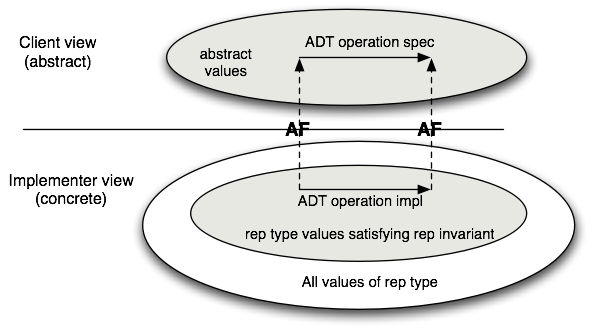Representation Invariants
The abstraction function explains how information within the module is
viewed abstractly by module clients. However, this is not all we need to
know to ensure correctness of the implementation. Consider the size
function in each of the two implementations. For ListSetNoDups, in which the
lists of integers have no duplicates, the size is just the length of the
list:
let size = List.length
But for ListSetDups, which allows duplicates, we need to be sure not to
double-count duplicate elements:
let rec size = function
| [] -> 0
| h :: t -> size t + (if mem h t then 0 else 1)
How we know that we don't need to do this check in ListSetNoDups? Since the
code does not explicitly say that there are no duplicates, implementers
will not be able to reason locally about whether functions like size
are implemented correctly.
The issue here is that in the ListSetNoDups representation, not all concrete
data items represent abstract data items. That is, the domain of the
abstraction function does not include all possible lists. There are some
lists, such as [1; 1; 2], that contain duplicates and must never occur
in the representation of a set in the ListSetNoDups implementation; the
abstraction function is undefined on such lists. We need to include a
second piece of information, the representation invariant (or rep
invariant, or RI), to determine which concrete data items are valid
representations of abstract data items. For sets represented as lists
without duplicates, we write this as part of the comment together with
the abstraction function:
module ListSetNoDups : Set = struct
(** Abstraction function: the list [a1; ...; an] represents the set
{a1, ..., an}. [] represents the empty set.
Representation invariant: the list contains no duplicates. *)
type 'a set = 'a list
...
If we think about this issue in terms of the commutative diagram, we see
that there is a crucial property that is necessary to ensure
correctness: namely, that all concrete operations preserve the
representation invariant. If this constraint is broken, functions such
as size will not return the correct answer. The relationship between
the representation invariant and the abstraction function is depicted in
this figure:

We can use the rep invariant and abstraction function to judge whether the implementation of a single operation is correct in isolation from the rest of the module. It is correct if, assuming that:
- the function's preconditions hold of the argument values
- the concrete representations of the arguments satisfy the rep invariant
we can show that
- all new representation values created satisfy the rep invariant, and
- the commutative diagram holds.
The rep invariant makes it easier to write code that is provably
correct, because it means that we don't have to write code that works
for all possible incoming concrete representations—only those that
satisfy the rep invariant. For example, in the implementation ListSetNoDups, we
do not care what the code does on lists that contain duplicate elements.
However, we do need to be concerned that on return, we only produce
values that satisfy the rep invariant. As suggested in the figure above,
if the rep invariant holds for the input values, then it should hold for
the output values, which is why we call it an invariant.